|
Updated Dec. 03, 2006......................................................................................
Chile
October 4, 2006
It’s chilly in Chile.
We arrived on a LAN flight around 6:30pm. The flight lasted 4.5 hours BUT did not have the view screens in the back of each seat. To date, we’ve been very spoiled because almost every airplane on which we’ve flown has had the individual video screen on the back of every seat. Many of these even have movies on demand. When you add the games and music, it’s a veritable party in your seat.
At least that’s how my kids view it, and it’s how I view it, and it’s how we began a love/hate relationship with LAN Airlines.
On our first outing with LAN Airlines we took a flight from Tahiti to Easter Islands that left Tahiti at 12:30 am. That’s 30 minutes after midnight—who planned this?! This flight was about 5 hours and they offered EVERYTHING—games, music, TV shows, and about 8 different movies, all on demand, all on your little video screen on the back of the seat in front of you.
Of course we all feel asleep so their wonderful entertainment selection was for naught. Oh, the irony, eh?
Our second experience with LAN Airlines was a trip from Easter Islands to Chile that started at 1pm (this is the afternoon, where everyone is still awake and eager for entertainment). Not only did this flight NOT have the individual video screens for their passengers, but they showed about 2 hours of crap, followed by the movie, “The Sentinel,” which was about 1.5 hours of crap, then we landed.
So the entire flight was about, uh, crap.
October 5, 2006
In Chile, over-the-counter (OTC) medicines are really Over the Counter—you cannot get anything stronger than toothpaste in a self-serve atmosphere. If you want ibuprofen or something for a sore-throat, or diarrhea, or whatever, you need to get it from the pharmacist. That is, you must walk up to a counter and tell the pharmacist that you want either a specific medicine, or medicine to help 'XXX' symptoms. There is no such thing as comparison shopping for medicines in South America. This is a bit strange for us, but cheap at about 1/10 what we would spend in the states (NOTE TO READER: Chile and Argentina have cheap medicines; Peru does not.).
Let me enlighten you to the electrical system in Chile. It’s difficult to understand any standards. In the U.S. a light switch turned UP means on; turned down means off. That’s pretty much a standard unless you have some sort of three-way thing going, then you need to get your priest involved for absolution.
In Chile, the on/off switches are left/right. This should not be a problem, but I’ve not been able to find any consistency in the on/off position. For some lights, left is on; for others, right is on. I’m not sure the electricians here really care about consistency.
But we Americans all know about the bank of switches that permeate every middle-class American household. The inevitable horizontal row of 4 or 5 switches in the main living area that need to be labeled because nobody can remember what switch controls which light(s) or outlet(s). You are familiar with this, right?
So take ambiguity of the left/right on/off switching and add multiple switches along each wall that control various light fixtures along various walls. Many of these switches do not control lights that are reasonably close to their switches; some switches control a light on different walls. Now you understand the hidden agenda that Chilean electricians have—I think they are all employed by “American Home Videos” and they are recording all our attempts to light our living spaces, recharge our appliances, or use anything electrical.
Darren’s Guide to Speaking Spanish
They speak Spanish in Chile; they speak Spanish in most of South America, as well as most fast-food restaurants in Los Angeles and Miami. Nicky and I took many years of Spanish in school that is not helping us at all right now. I actually took four years of Latin prior to taking 4 semesters of Spanish, and the Latin is becoming a hindrance with my spreken zi Espanol:
Darren: What’s the Nominative past-perfect form of “buy?”
Nicky: Nom-a-what?
Darren: I’m trying to figure out the future-perfect conjunctive form of “have.” What’s “have” in Spanish?
Nicky: Tener. Remember it’s an irregular verb. Tengo is, “I have.”
Darren: Si. Tengo un problema con hablar Espanol. (Yes, I have a problem speaking Spanish)
Nicky: sí, por supuesto (Yes, of course)
Darren: ¿Quizás necesito los servicios de un traductor muy bonito?
(Perhaps I need the services of a very pretty translator?)
Nicky: Sí, aquí soy! (Yes, here I am)
Darren: How do they make the question marks go upside down?
Spanish Translation: ¿Cómo hacen ellos el signo de interrogación va al revés?
I’m not even sure if the questions I posed about Spanish grammar above mean anything. I vaguely remember things in Latin class about Nominative, Subjunctive, Declarative, past participle, and past-perfect-future superlative 3rd person singular, and something about a gerund; these are just strange words and phrases to me now with just about no meaning. But I like throwing them around just in case someone doesn’t question me about them and then they think I’m much smarter than I really am.
Plus I know a guy named Gerund and I think it’s a cool name.
So in the short time that we’ve been in Spanish-speaking Chile, I’ve developed a very simple method of communicating with the local Chilean people, in Spanish, that is derived from my Latin/Spanish classes and Nicky’s Spanish classes, as well as in-the-field practice. You may not be able to hold long and meaningful conversations with this method, but you will be able to buy groceries and gas, make some friends, and ensure that the American-Chile relationship remains healthy and strong. This guide is results-oriented, meaning that you have a goal in mind and I will provide you with the language tools in which to attain your goal.
I’ve put a sample of my, “Darren’s Guide to Spanish” course into table format below. For further information and pricing, please contact me: Darren Rousseau:
| English |
Spanish |
| Greetings. How are you today? |
Hola. Como esta usted? |
| My name is Darren. I’m from the United States. |
Me llamo Darren. Soy de Los Estados Unidos |
| I’m sorry; I didn’t understand what you just said. |
Open eyes widely and shrug shoulders. A vague, “Huh?” is appropriate here. |
| How much is this milk? |
Point to the milk bottle, then wip out your cash and give the deer-in-the-headlight look. Say, “Quanto?” which might mean, “how much?” but it also might mean, “what,” “where,” “how,” or, “when?” I don’t remember the question verbs very well. |
| Please fill the car with 93 octane petrol |
Pull up to the full service pump (they’re all full service here). Roll down the window and smile and say, “Hola. Coma esta usted?” (See above). Now you’ve just made a personal contact with your new-found friend; you’ve established a long-lasting and deep rapport. He will most likely rattle off your choices of gas and ask you how much petrol you wish to purchase. It’s either that or he’s asking for a number for the lottery.
This is what I like to call, “Speaking in context.” You’re pretty sure you’re gonna get asked questions about gas at a gas station.
So listen for the following: “siete” or “cinco” or “tres” (which mean 7, 5 and 3 respectively). These are the octane ratings—97, 95, or 93. They’re usually preceded by, “novente” (which means 90 and is pronounced “nobente”) but you won’t be able to hear it because they talk at near light speed here. Just try to concentrate on the last syllable.
To answer this question, you just need to say, “tres.” Alternatively, you can hold up 3 fingers. The guy will understand that you want to put 93 octane fuel in your car. No need to put the expensive octane rating gas into your rental car.
Then the attendant will rattle off about 15 seconds of gibberish, to which you say, “yeno.” This is actually spelled, “lleno,” which means, “full.”
So now you’ve successfully filled your tank with 93 octane fuel!
|
| I’d like a small coffee please, in a to-go cup. |
“Café, por favor.”
The coffee attendant will rattle off a bunch of unintelligible words which really is probably something about his aunt’s donkey and don’t add anything germane to the conversation. I think they make up some of these words on the fly because they speak for such a long period of time at such a high rate of speed that they must either be making it up or reciting their country’s anthem.
So after they’ve recited their anthem, just smile and nod your head and point to the size cup you want, and say, “negro, no azugar,” which means, “black, no sugar.” If you want something else besides black coffee, then you’ll have to use someone else’s Guide to Spanish.
|
Of course there will be those times that you do not initiate the conversation, and someone else comes up to you and starts speaking. This happened to me this morning at the supermarket (translated: supermercado. It seems as though every English word has some different Spanish word). A lady came up to me and the girls, smiling and rattling off something unintelligible to me, while pointing to the girls. Because I’m extremely adept at English-Spanish translations, I knew she was saying one of the following things:
- Your daughters are very beautiful. Look at their very blond hair and fair skin (my daughters have very blond hair and fair skin, which is rarely seen in this part of Chile).
- I would like to take your children home and raise them as my own. Is this amenable to you?
So I nodded my head, said, “Gracias” (translated: Thank You), and continued to say, “Si” (translated: yes). So I was either acknowledging her compliments to the girls and thanking her for them, or giving her permission to take my kids home with her.
I was OK with either scenario.
Basic rule of Darren’s Guide to Speaking Spanish: if in doubt, just smile and say, “Si.”
So I hope that this small tidbit of, “Darren’s Guide to Spanish” is helpful to you. It’s a very small guide and I’m in the process of finalizing, “Darren’s Definitive Guide to Spanish.” This will help you comfortably converse with the local people in a more convenient, conversational and informal setting. This guide doesn’t conjugate verbs (I used to remember what that means…); instead we’ll offer real-world solutions to real-world problems. I’ll supply the translated questions to everyday real-world issues like the following:
- Where can I find the best disease-free hookers?
- What’s the best place to purchase pirated DVD movies?
- Passport? What’s a passport?
- Has anyone found my very expensive Rolex watch that I lost?
- I have an itch in a very embarrassing area. Can you recommend a good doctor?
- Which is cheaper, the rum or tequila?
- I have a flat tire. Do you know of someone that’s working on the side so I can get this fixed at below-market rates?
Now I’ll move back to the prose form of writing at various times. At times I may put dates into the story in order to keep you, the loyal reader, informed and updated.
We got a rental car from Alamo and the guy at the counter spoke a bit of English. Combined with my heretofore Spanish Guide, we were able to communicate well. We were shown to a dark alley in which contained our rental vehicle—a Nissan Pathfinder, about 3 years old, with 24,000 KM on it, and lots of scratches from previous renters.
It was in really good shape if you ignore all the scratches and dents. The inside was pretty much perfect. But it was dark outside and the non-English speaking car guy was adamant that he and I look at the outside of the car and document every scratch and dent. This was time-consuming and it was cold and dark and we were all tired, thirsty and hungry. I’m sure I could have done a more thorough job given, uh, light, but we were eager to move on.
October 4, 2006
Our first stop in Chile was a pre-arranged farm stay at Fundo Chacaipulli, which I think means, “Chachi’s place of Fun” but I could be wrong. From this point on, it will be known as, “Ian and Maggy’s place” or IMP.
I’m a not a big fan of acronyms, such as IRS, or NSA, or FBI. Not that they have any personal meaning to me, but I’d just as soon not know them on a personal level. Regardless, I will continue to refer Fundo Chacaipulli as IMP even if the US Government has some sort of problem with this. Consider this my way of individual revolution. Or at least my attempt at least-effort typing; acronyms are easy on the typing fingers…
Now this is a really cool place; Ian and Maggy are wonderful people. Nicky had booked this earlier via their website and we’d talked with them via email. One of the cardinal rules of Nicky/Darren travels: if we book via online, the hosts MUST respond quickly and courteously. IMP passed our test with flying colors.
Our success rate thus far has been almost 100% satisfaction. We had a curve ball thrown at us in Florida at a horse farm there. If I were online right now I’d post the website of the horse farm where you would NOT want to stay…
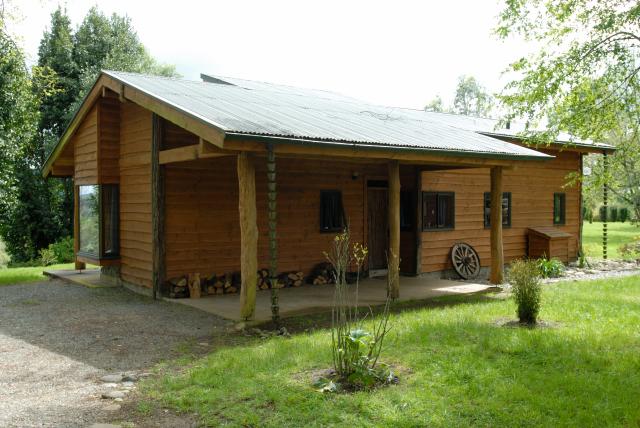
So we booked a stay at Fundo Chacaipulli, which is really Ian and Maggy’s Place (IMP). We were greeted very warmly by Ian and Maggy with hugs and firm handshakes and huge smiles--uh, she hugged; he shook hands. Things were above board at IMP.
They showed us to the lodge which is about 1300 sq. ft of wonderful timber framing with a huge stone fireplace that was heated by a wood stove. There were two bedrooms and two bathrooms with a third bed in the loft. The place is awesome—it has huge windows that overlooked the farm’s valley.
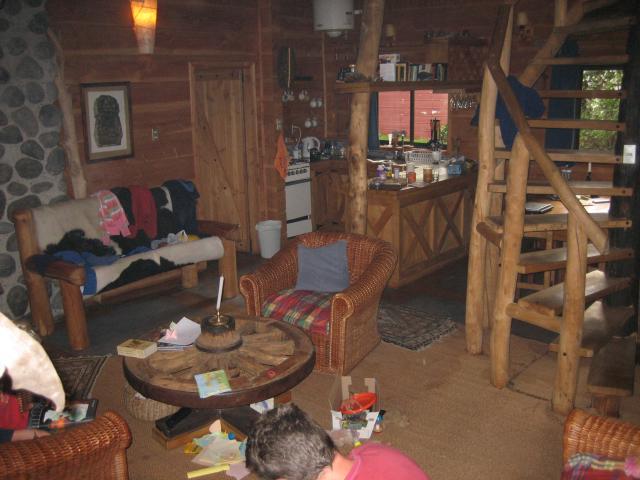
Prior to our arrival, and prior to most of our arrivals at places, we usually stop at a grocery store to buy stuff that we need. Stuff like food and drinks; you know the things that people usually need to live. But when we went through the town of Los Lagos in order to get to IMP, we couldn’t find any food places at all. So we arrived at IMP with a bottle of water and half a loaf of bread. Really—no hyperbole at all. I thought that we would have to gather grass to put on the bread to give us some nutrition.
Ian and Maggy had previously offered to host us for dinner the following night, but since we arrived with no food they quickly offered to host us for this evening. Not only that, but they gave us a bag of chips, a bottle of wine, a liter of beer and some other snacks. I knew we’d like this place immediately—why would you NOT like a place where the owners greet you so warmly? And give us beer?…
The food and conversation during dinner was really good. Ian was a previous Chief Executive in an automotive parts store and they left that life to sail for about 4 years until they ended up in Chile. What a great story! What an amazing life change! Now they own about 240 acres of farm land with a bunch of cows and sheep and they’re getting into the honey business. More on this later.
So our days here consisted of sleeping late and riding horses with Miss Maggie. The horses are wonderfully tame and Miss Maggy does a really great job helping us to learn how to ride them. It’s not surprising that Maggy comes from a teaching background—it was pretty obvious by how she interacted with our girls.
So we stayed at IMP for about a week and we cooked for Ian and Maggy one night, although the dinner was a spicier version of chicken and cheese grits that I normally make. They invited us to their house for a second time for fish and we were won over again by their hospitality.
One rainy day they took us to a natural hot spring that featured architecturally made hot tubs. What a great place!
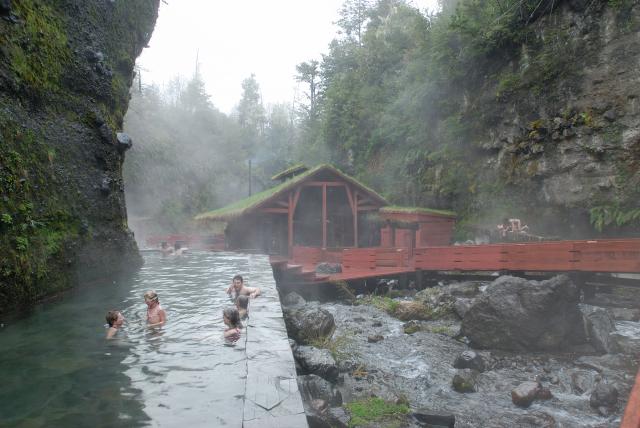
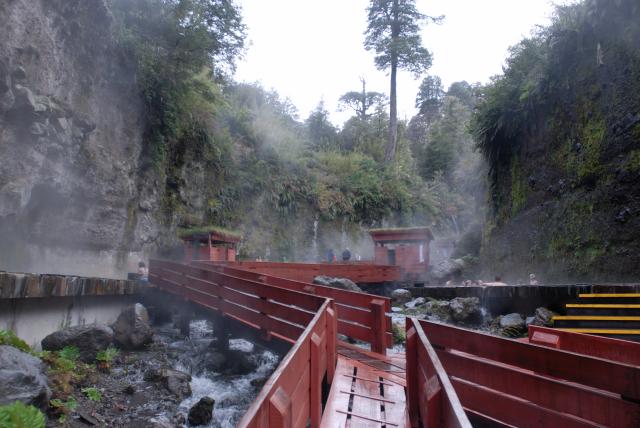
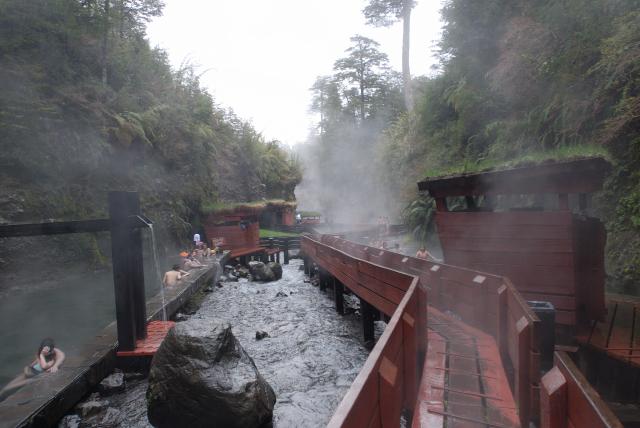
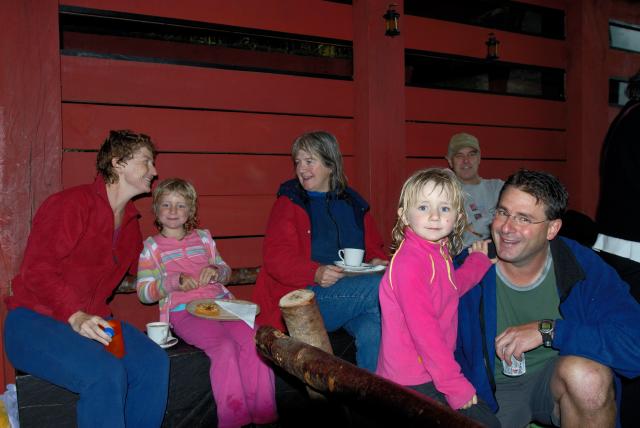
Of course, there are some pictures that we took that just aren’t made for your viewing pleasure. Did you know that many of the men in Chile wear the very small Speedo bathing suits? Many of these men should be wearing bed sheets, not Speedos. Seriously, with that much flesh and hair you’d think they’d have a dress code here and offer robes or, uh, curtains or something.
All of this is heated from the volcanic gases, which Nicky will say is similar to our cabin in IMP where we’re staying. I’ll never ‘fess up to the smell—I blame it on the kids every time. And half the time I’m right…
But IMP was a place that we could live comfortably and ride horses and do some art and practice the banjo. And I ventured into the Chilean internet realm.
At most places we go, I try to find a place that will allow me to hook up my laptop to the internet by either wireless or cable plug in. I approached 3 internet sites and none offered either service, but at $2 per hour, I really wasn’t too upset with this. But it’s really difficult to upload files for a website if you don’t have your own computer—many internet cafes don’t allow uploads from USB sticks or CD ROM’s. So my strategy is then to put my laptop on the passenger side of the car and put it in WIFI hunting mode—I’m looking for unprotected wireless networks that I can tap into.
Yes, in the US this is illegal and it’s probably illegal in many other places, Chile notwithstanding. I think the first US prosecuted case was about a year ago in St. Petersburg, FL and the guy was found guilty, although I don’t know what his sentence was. I realize that this is the typical economic free rider problem and as an Economics major I have a big problem with free riders, but personally I have no issues with my “stealing” of someone else’s wireless bandwidth for several reasons:
- My use is extremely limited--just email and maybe 2-3 websites. Not a huge drain on their bandwidth.
- To date, all the WIFI that I’ve “stolen” have been after-hours public places like hotels and restaurants. Had I known that they were WIFI enabled places, I would have gladly paid for a coffee or a beer in order to use their wireless internet.
- I understand that I’m justifying my use of someone else’s legally paid-for services. I’m pretty good at justifying my illegal actions, regardless of the country at which we visit. At least I’m honest about it.
So the rest of the time at IMP was hanging out with Ian and Maggy and riding the cool Chilean horses. I felt very worldly because not only was I hanging out with an English couple and we were riding Chilean horses, but we were driving a Japanese car (Nissan Pathfinder), hanging around with their other guest Olaf from Germany, using a camera purchased in Australia (see Australia, Queensland for details on newly purchased camera to replace lost/stolen camera), and speaking Spanish (well, if making sentences like, “Hello. I wish bread please” is really speaking. Perhaps some modifiers are in order…).
We were able to take part in the yearly inoculation of their cattle. This means that we they had to round up all their cattle, bring them into a place at which they could record/tag/inoculate each cow. The noise/smell/sounds were outstanding. It was like being at my brothers house after eating a bunch of burritos and drinking lots of beer. Except I didn’t have to undo my belt, but I undid it anyway.
Video: Cattle Drive
Note: if you can not see the video, download QuickTime and view the movie with it.

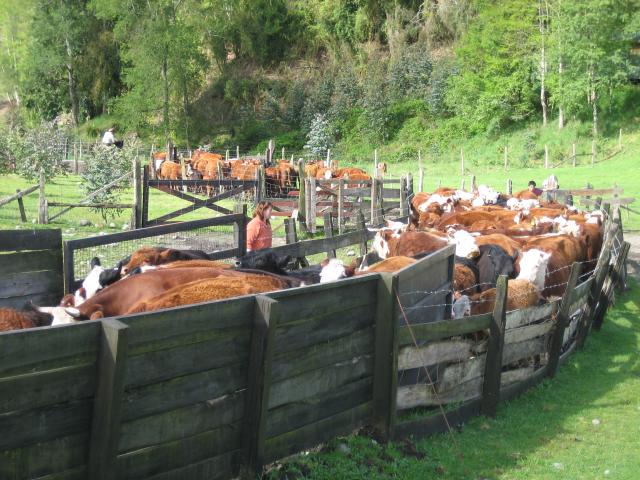
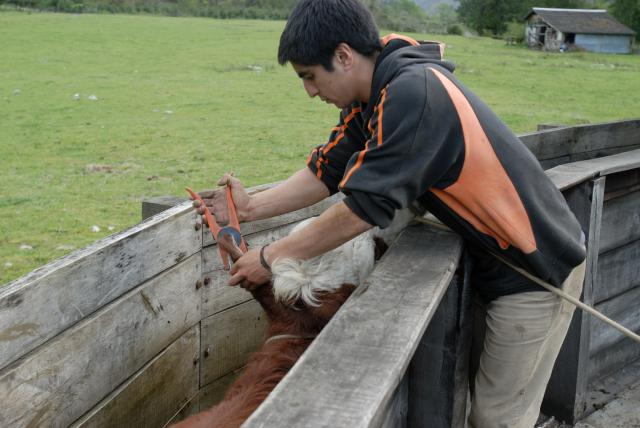
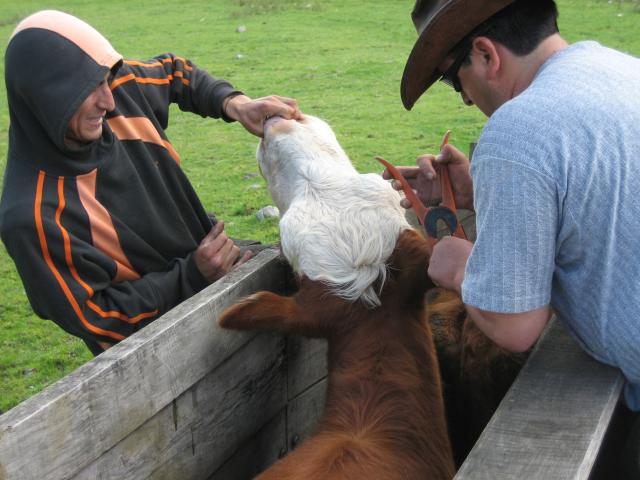
The weather at IMP didn’t cooperate enough for me a spend time with Ian to help tend his bees, but keep reading for some bee stuff yet to come. It’s unBEElieveable.
That’s so bad--how did I have the testicular fortitude to write that? I’ll never know…
From IMP we traveled down south to an island called Chiloé (pronounced Chiloé). This is, fortunately, in the X region, or the 10th region, or the Los Lagos region, the same region that IMP is in. What the heck is this?! Chile is divided into thirteen regions, each of which is headed by a leader appointed by the Chilean president. The regions are denoted by the Roman numeral; X region is the Los Lagos region. Because these leaders are appointed by the Chilean president I’m not sure there’s a good US equivalent. But it seems to me to be a regional form of government, which I’m not so sure is a good or bad thing. All I know about the Chilean government is that every business establishment MUST write receipts for even the smallest things, and their receipts MUST be on receipt paper that has the Chilean governments stamp on it. If you don’t adhere to this, there’s a HUGE fine in the hundreds/thousands of dollars. Ouch!
Anyway, Ian and Maggy recommended a bed and breakfast place in Chiloé hosted by their friends. We figured, “Hey we like you guys, we’ll probably like your friends” and we decided to spend 5 days with their friends called Marc and Francoise de Lesseps.
What a cool couple. These guys came from France and settled in the tiny island of Chiloé (8,394 sq km or 3241 sq mi). They traveled from France with their children and they decided to make a home in Chile (Santiago originally, and then settled in Chiloé). Once they decided to move to Chiloé, they purchased a bunch of land that was only accessible by driving their 4-wheel drive truck on the beach during low tide. Their access was blocked by high-tide! What an amazing experience it must have been to transport all the people and building materials ONLY during low-tide, or about ½ day.
Actually, after a bit of thinking, I realize that Marc is much smarter than the average bear—access to the house for about ½ day means that you can only work on the house for about ½ day. The rest of the time is for rest! Brilliant! I always thought it was better to work smart than hard.
And the place is amazing. What a wonderful house they’ve built, although it’s customary for Chilean Maestros (i.e. carpenters) to use wood that hasn’t thoroughly dried, so significant cracks appear after the first and second years of building. Huh—you’d think the maestros would have figured out this problem a long time ago.
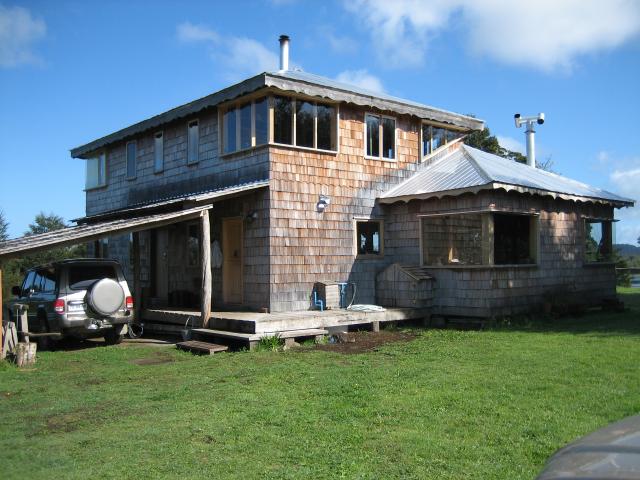
Marc and Francoise are French. He speaks English very well; she understands English very well, but doesn’t speak English so well. But she used to own a restaurant in Santiago and watching her cook is like watching the Food TV channel—she whipped up a quiche in about 8 minutes, including the time it took for her to make the crust from scratch! Very efficient—I think I’ll clone her.
These guys are yet another amazing couple. First of all, he’s French royalty. Marc is a real French Count. Seriously...
So Marc—you were telling the truth!!! But in the picture below, he’s not wearing a cape or a crown or anything. He doesn’t have a scepter and he’s not denigrating a jester or anything. So there’s still some question as to his royalty status.
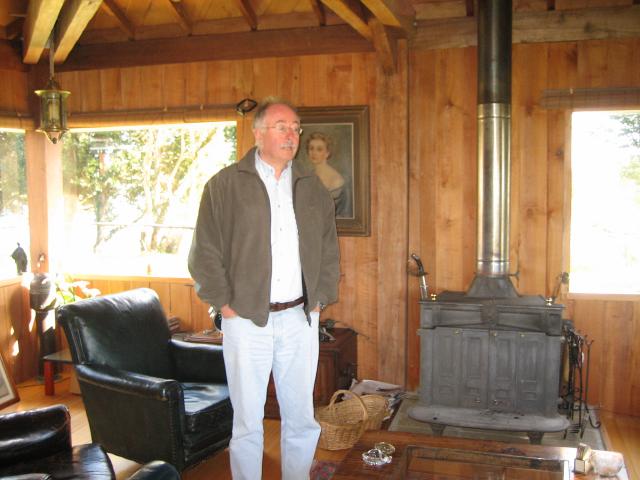
But really, who knows anything about a Count or a Duchess or a Marquis? Outside of Count Vlad Dracula and the Count on the PBS series, “Sesame Street,” and the Duchess of York and the Marquis De Sade, where does a royal figure like a Count fit into daily life?
Well for me and Nicky and the girls, our Count made sure the house was warm and we had enough to eat and he made sure we experienced Chiloé to its fullest. He offered wonderful hospitality, and he made fun of the fact that he was a Count; I did too, which was a great source of camaraderie. If you can make fun of yourself, then you can make fun of others—that’s what I always say. Marc was wonderful poking fun at himself—what a great guy!
If you know of other Counts, or Dukes, or Princes, or even if you don’t, you should know the following pecking order:
- King, Queen—these are the head honchos. One of these guys has royal blood. This is the difference between royalty (i.e. family-related) and nobility (granted royal status because of something they did, like Sir. John McCartney and Sir Mick Jagger).
- Prince, Princess—usually sons and daughters of the King/Queen. Again, royal blood is the key here. Again, Royalty means blood; Nobility means rank/ability. This is something that I just learned in researching all these titles. I tried to make this personal so I could know where I stand: I’m a father (by blood, royalty) and I’m a husband (by rank, nobility).
- Duke, Duchess—in France, the Duke/Duchess outranks the Prince/Princess. This is opposite to England royalty.
- Marquis, Marchioness—noble people ranking below a Duke and above a Count. Can you believe this definition? It came from www.dictionary.com. If you’re Marquis de Sade then you’re turning in your grave, eh? There’s gotta be a more meaningful definition somewhere.
- Count, Countess—this term literally means, “Companion of the emperor, or delegate of the emperor.” Good on ya, Marc and Francoise! Ooops, I just slipped into Australian-talk...
- Baron, Baroness—I’m not sure where these guys fit into the whole royalty thing, but I’m sure they’re at the bottom rung, but they’re a huge step up from the following:
- I thought that I’d add the following US royalty rankings here in the spirit of International cooperation (as of 2006):
- Chief Executive, Exxon-Mobile Corporation
- Chief Executive, Wall-Mart Stores
- Chief Executive of any of the huge lobbying companies in the US
- President of the United States
- CEO of CNN
- CEO of Krispy Kreme
- Vice President of the United States
- My daughter (I told her she could be leader of the US one day...)
- Speaker of the US House of Representatives
So I learned a couple of things here:
- Count is a pretty high level of royalty—it’s inside the Top 5 of Royalty Titles. Although I’m pretty upset that Marc didn’t walk around with a crown and cape, I’m equally happy that he didn’t make us bow to him every time we saw him...
- My Count served me coffee. And he had a great sense of humor—perhaps he was a Jester instead?
- I love that I can say the phrases, “My Count...” and, “I have a friend who is a Count...”
- Marc (aka “Count Marc,” aka, “My Count”) was wonderfully hospitable and made much more fun of his title than I do here.
- When we first booked our stay at Marc and Francoise house and we heard that he was a French Count, can you feel the horror that resided in our hearts? We figured that we had to dress up for dinners; that we had to bow to him and walk down the long carpet runner; that we had to prove ourselves by slaying the Dragon (I made up this last part because the Dragon was already slain by a previous renter).
Our entire stay at Chiloe was marked by the wonderfully friendly and hospitable Chiloen people. They grow people extremely short here—the average Chiloen person here must have been about 5 feet 4 inches tall. They are really short. It’s a small island and most of the population has never traveled off of this island. But they are equally friendly and hard-working.
Our stay here wasn’t marked by any one thing. We hung around the house quite a bit, took walks on the beach which is also their 2nd avenue of access to the house. We spent some time looking for a small museum called, “Prehistoric Museum.” This is one of those things like the big ball of twine, or the world’s largest skillet. This is a “museum” that’s held at the house of an amateur archeologist. It’s a hodge-podge collection of some really bad stuff; bad enough to make it interesting. Like these really badly stuffed animals:
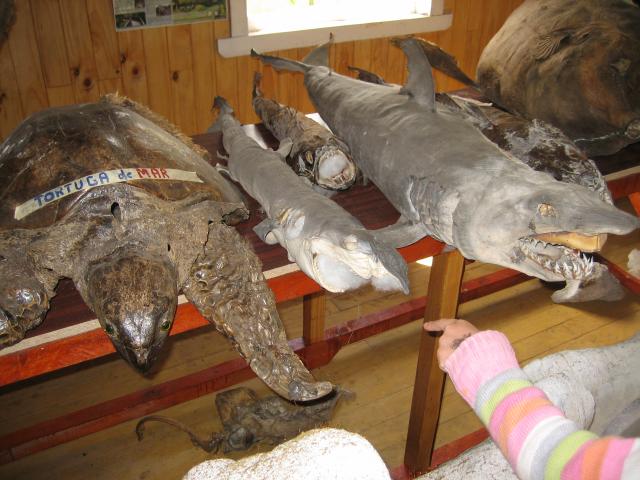
Or his baleen whale skeleton:
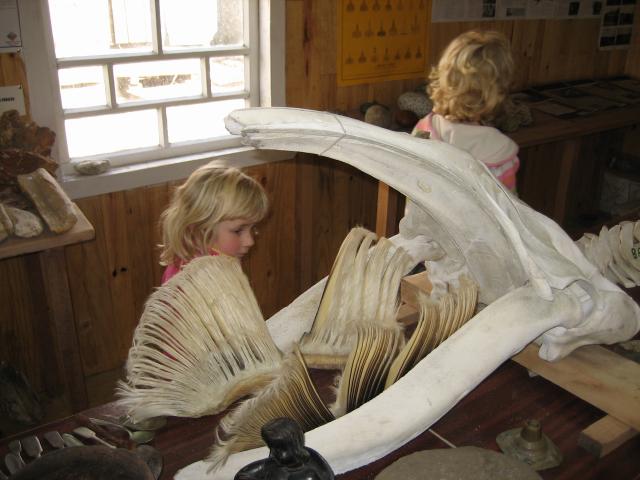
But I like the skeleton of the large whale that sits outside of the building. He didn’t have all the pieces to the skeleton so he made up the missing pieces from wood. Ha!

This is definitely Route 66 material.
One of the more interesting things for me was to see the city wiring. Yes, for most of you that don’t enjoy the process of how they built the Chunnel or how wool is turned into yarn (see our New Zealand for information into this process), or how hydraulics work, then you might not be interested in a small city’s attempt to control wires. But I tell you once you look at this picture I’m sure your interest will peak:
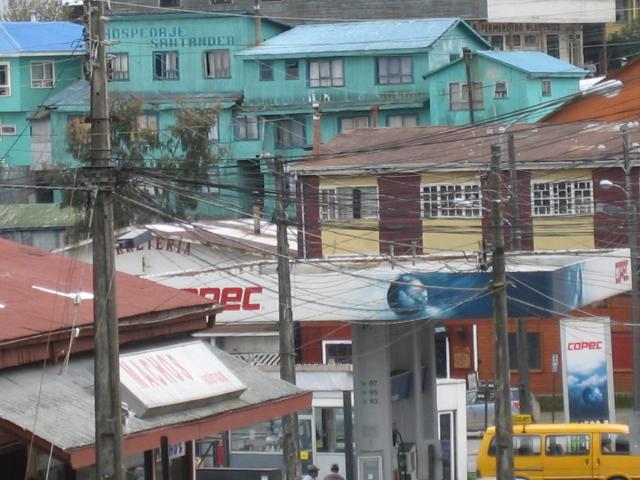
There were many better examples of poor wire management but I did not capture them on film. But this picture led to the following conversation between me and my lovely wife, Nicky:
Nicky: Are you taking a picture of the gas station?
Darren: Nope. I’m taking pictures of the wires.
Nicky: (pause) Wires?!
Darren: Yup. This is really poor wire management. They have electrical, phone and data cables all messed up and tangled. You don’t see this in the states. Pretty interesting, huh?
Nicky: I’m sorry, did you say something? I was measuring my cuticles with this portable protractor.
OK, so Nicky’s not into wires, but my point is that city wiring, like water, sewage and electrical services, are the most basic of consumer needs. Seeing the pride and efficiency with which an area does this says a lot about their community… I just re-read this sentence and I can see how I resemble a bit about Captain Ahab here. But I’d like to impress upon you, the loyal worldsmartkids.com reader, how important little things that we take for granted like water, electricity, sewage, and wiring mean to our everyday lives. If we can just come together and agree on this and experience the wonder and joy it is to understand our everyday workings; if we can just say, “Thank You” to those countless and faceless people that keep our toilets from overflowing and our water drinkable, then I think we’ll all be better people.
One of the things that we successfully did before we left Count Marc’s place was to cook them dinner. We cooked the same dinner for Ian and Maggy, and we cooked the same dinner for the Shenton’s (Western Australia). It’s our old standby—Chicken and Cheese Grits. My buddy Craig Popelars adapted this from a great restaurant in Chapel Hill, NC called Crook’s Corner. Their dish was called Shrimp and Grits, but I’m not fond of Shrimp so we substituted chicken. The recipe is:
- Crisp lots of bacon
- Take the bacon out and break into little pieces. Keep the bacon grease in the pan. Bacon is the key ingredient to this dish. Oh, lots of cheese as well. So really the main ingredient in this dish is neither chicken nor grits—it’s lots and lots of greasy fat.
- Cook the chicken/shrimp/beef/meat of your choice in the bacon pan with the grease. Are you understanding why this dish might be tasty?
- Add mushrooms, green onions, other veggies you might like, plus a bit of heat. I like to add a combo of red pepper, black pepper, paprika, and a bunch of green spices. Add the crisped bacon and a bunch of fresh parsley to finish this part of the dish.
- For the grits: cook grits per directions. Put a ton of grated sharp cheddar cheese in it. It’s a wonderful food with a great creamy mouth feel.
- To serve: take a heaping of the cheesy grits and spoon on a plate and flatten like a pancake. Then put a couple spoonfuls of the meaty stuff on it. Make sure you get a bit of the juice that should be there. Then top with a bit more green and red spices to jazz up the dish.
This has never failed to make people love my cooking, although it’s not my dish I’m quick to tell people that it is. Unfortunately for Ian and Maggy I put too much of the hot spices in there and it was a bit more spicy than normal. But I think I did it perfectly for Marc and Francoise.
But this exercise at cooking for IMP and Marc/Francoise was interesting for several reasons:
- We wanted to give back for the exceptional hospitality that Ian and Maggy as well as Marc and Francoise gave us. And our efforts were extremely well-received, regardless of how well I cooked the dish.
- I can buy grits at any grocery store in North Carolina—apparently they haven’t heard of this delicacy in Chile. So substitution is essential, and it was fun trying to find the exact ingredients and finding an equivalent substitute if needed. Polenta is a natural substitute for grits that we found at IMP, but at Marc’s place we found some bizarre sort of hominy/pasta/flour mixture that scared me and took a TON more water and milk to get creamy.
- Chilean bacon is much less fatty than American bacon. Actually, so is New Zealand, and Australian bacon (they both call them rashers). They also cut them thicker. So while this is much healthier, it’s very difficult to get the bacon to crisp.
- It’s so easy to serve this recipe to unknowing customers. It’s like playing the banjo for people that have never heard the banjo—they don’t know if you’ve made a mistake. They’re a willing and forgiving audience.
Before we left Count Marc’s place, he hooked us up with a local school. During a talk about us schooling our children, Marc mentioned that we might be able to take our kids to tour one of the local schools. What a great experience, we thought. He made some calls and said that we’d be able to tour the school, and have the kids stay there for the day! Awesome—we could have the kids experience a real day at a Chilean school and we could have some free time as well! A win-win situation if ever I saw one.
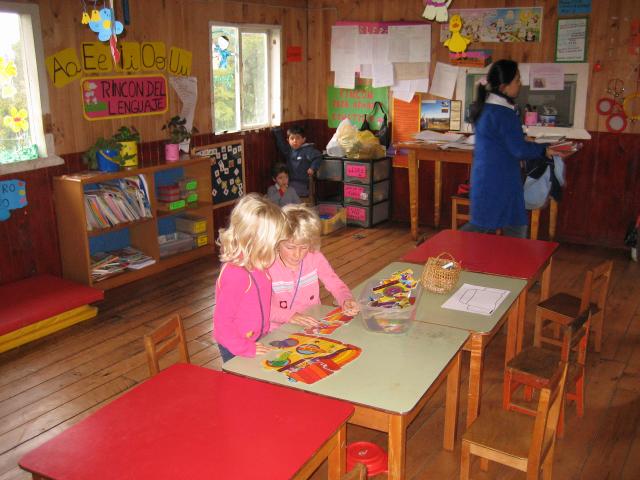
So did Dominique’s sweater, but we forgot that she took it there. But the school was wonderful. This was mostly a pre-school staffed and run by volunteers. They had kids ages 4-5, spoke no English, and had one teacher and one person that ran the kitchen. The entire building was about 800 sq. ft. and had a full kitchen, one school room, and bathroom. The schoolroom had a bunch of puzzles, coloring stuff, bright drawings on the walls, and a lot of free space for the kids to play. On this particular day there were only 4 kids there when we brought Dominique and Annette there. Because of their blond hair and fair skin, they were met, as usual, with trepidation and curiosity. The teacher and the cook (both volunteers) were really great with the kids and welcomed them to the school and integrated them with toys and playthings with the other kids.
This was at 10am. The plan was to leave both kids there and run away like crazy before they knew we were gone.
Uh, I mean, the plan was to carefully and slowly integrate them into the new and strange environment; one that not only is different culturally, but also with different age groups as well as different language.
Regardless, we were to pick them up after school which is about 1:30. They were both to have lunch there. But as expected, Annette, aka The Shy One, didn’t want to stay so she came back with me. Dominique was a trooper and stayed there and had a wonderful time even though the teacher knew only a tiny bit of English. Nobody else knew any English, and Dominique knew the important words—yes (Sí), no (No), and bathroom (baños). We really pigeon-hole our children and ourselves if we think there is a communications barrier. The barrier is self-imposed—Dominique had a wonderful time and wanted to go back the next day. I figure there’s someone feeding her chocolate or some other form of sugar…
One of the other interesting things I saw was a boat-maker making Marc a small sailboat. The interesting thing about this is that it’s all made by hand—he has a small amount of electric tools, but he still does a lot of work with hand tools. And here’s the kicker—this is how they bend the wood:
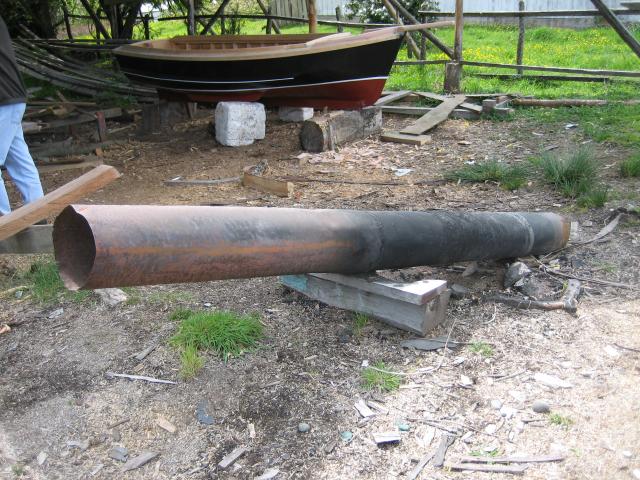
They put the wood inside the tube, fill the tube with water, and heat the tube from the outside. When the wood is wet and heated enough, they take it out of the tube and shape it. Pretty cool, eh?
So then we left the island of Chiloé. Our plan here was to slowly make our way north to Santiago to catch our flight to Argentina. At this point, we had about 10 days to experience some of Chile before we have to catch our flight. No problem—Chile is a really long country being about 4,300 km or 2,700 miles long (New York to Los Angeles is 2462 miles). OK, we didn’t travel the entire length of Chile but we did do some driving while we were here. Our travels were only about 606 miles one way, or 1212 round trip (about 1950 km round trip). That’s a good bit of driving, regardless of where you’re going or who you are. Translated from a father’s perspective: that’s quite a bit of videos that you allow your daughters’ to watch, quite a bit of driving that your wife does, and quite a bit of sleeping that you do. But it’s uncomfortable sleeping, so it really doesn’t count as rest time does it? I feel as though I’m doing my part in upholding the parenting/traveling burden. It’s always important to have one adult that is well-rested in case of emergencies.
October 21, 2006 (Puerto Varas)
The first place that we stayed heading north after Count Marc’s place was a really cool town called Puerto Varas. We’d stayed here for one night during our journey down south and we liked the town so much that we thought we’d spend more time here. There’s a bit of German influence here, and I’m not sure how I can tie that into any kind of joke or witty saying right now.
We found a hotel that had cabins.
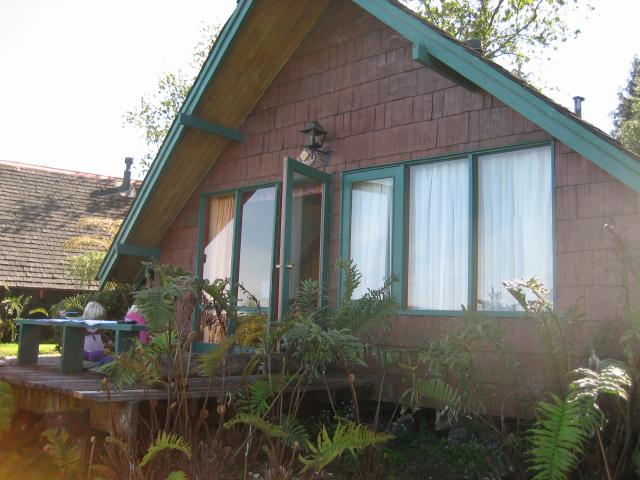
These cabins had wonderful views.
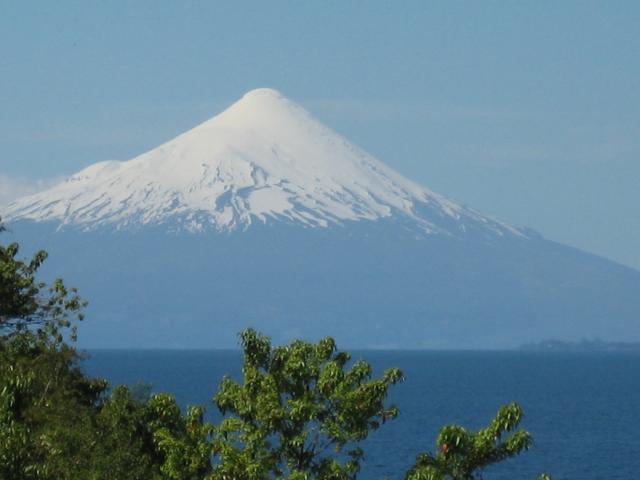
One of the interesting things about cabins in Chile is that your warmth comes from your experience and determination at making fires in the wood stoves. Of course this is an easy process if you are given tanks of gasoline and armed with hand grenades and flame throwers.
I grew up in Winchester, VA and we heated our downstairs (and some of our upstairs) with a wood stove. We had several cords of apple wood delivered every summer that gave us boys an opportunity to demonstrate our wood-splitting skills. When the cold weather arrived, it gave us teenagers the opportunity to demonstrate our fire-starting skills, and our woodstove heating skills. I fondly remember stoking the fire before going to bed and filling the stove with the biggest pieces of apple wood that I could find. The fire was so hot that I had to wear welder’s gloves, a ski mask and tin foil all over my body.
This is a really long story to illustrate to you, the faithful worldsmartkids.com reader, our attempts at keeping our family warm and free from frostbite.
The cabin here is small enough that the wood stove is adequate to heat the entire place. Our problem was that the flue was broken—we could not regulate the airflow coming into/out of the stove. This is a problem when you try to start a fire. It’s also a problem when you have a fire and want to regulate the heat.
The story to date: Nicky has been trying to get a roaring fire in the small wood stove since waking up from naps, which has been about 2 hours. She got a really good bed of coals, but no fire/flames mostly because the wood is pretty damp.
Before you berate me, I suggested to Nicky that she didn’t have to work that hard at building a fire, that we could contact the front desk and get an electric heater, but she took it on as a fun project; I thought a fun project would be for me to sit on my butt and read a good book. She gave the fire a great fight and finally succumbed to the Darren-way-of-thinking—let’s get an electric heater.
So Nicky was understandably frustrated and the cabin was understandably smoke-filled and I finally went to the office to request an electric heater. The lady there smiled and said that she would have someone bring it to us. Wuhoo!
Some guy come here with a handful of newspapers and dry kindling that was so small and dry that it would go off if you put it under a flashlight. He talked so quickly and moved quite rapidly and it was quite obvious to me that he was chastising our ability to make a fire.
He acknowledged the fact that our flue didn’t work (it doesn’t) and said to regulate the airflow we needed to keep the door ajar (which Nicky did). We knew this, but keeping the door ajar allowed a lot of smoke in the room (which we didn’t want). I specifically asked for a non-smoking room, so this didn’t jive with what we paid for.
So the dude yelled at us for a few more minutes and then stormed out.
I didn’t feel right about this. We’re paying $95/night here, which is a fortune in Chilean prices. I just assumed that at these prices, heat would be included. I understand that for some people wood stoves are normal, or a novelty, or something besides a hassle; this particular stove had become a hassle. And at $95/night, we didn’t need any hassles and we just wanted heat. Plus, I asked the lady at the front desk for ELECTRIC heat and she understood me and she agreed.
But that’s not what we got. So I really felt frustrated and angry. I went back to the front desk and had the following conversation:
Darren: I’m sorry; perhaps you didn’t understand me when I asked you for electric heat. I meant that I wanted something that plugged into the electrical socket in the wall and needed no tending from us, your customers. That is, nothing that needed a fire, or burning.
Smiling Receptionist: Yes, I understand.
Darren: But apparently you didn’t understand because you sent us a guy that yelled and us and told us that our stove flue didn’t work, which we knew, and told us that our wood was wet, which we knew. Please understand that we’re on vacation and we don’t want to be building fires and tending to them all night long. I can be frustrated with building a fire with wet wood at my own house—that’s why we’re on vacation.
Smiling Receptionist: Yes, I understand.
Darren: Great. So we’ll get some electric heat? I’ve been happy that the human race has been out of the Iron Age for quite some time…
Smiling Receptionist: Yes, I’m sorry for your troubles.
Darren: Thank you.
So after we finally received an electric heater, Nicky continued to stoke/feed/work the fire (hey I was working too—I made beef stew today and I fought off all the smoke while doing it). So here I sit, now 10:30pm at night, with a roaring fire in the wood stove, in our tiny cabana. If you’ve read our narrative from when we were in Thailand, you know how hot it can be there; if you can imagine ceramic tiles that liquefy, or papers that spontaneously burst into flame, then you can imagine how hot our cabana is like right now. I have ice packs around the computer, but they only last about 50 seconds. The shellac on the walls is peeling from the heat.
It’s really hot in here. Good thing we have electric heat now, huh?
October 24, 2006
Valdivia, Chile
The girls and I decided that we’d walk around downtown Valdivia for a bit. This is a small city in the Lake region, about 45 minutes away from Los Lagos, or IMP’s place. This wasn’t a place that we really wanted to visit, but it was convenient to shopping and sea lions.
This place is similar to the Pier 39 in San Francisco that has all the sea lions hanging around. But I’ve been to SF and seen their sea lions, and after seeing the animals in Valdivia, Chile, San Francisco animals are sorely lacking in both size and character:
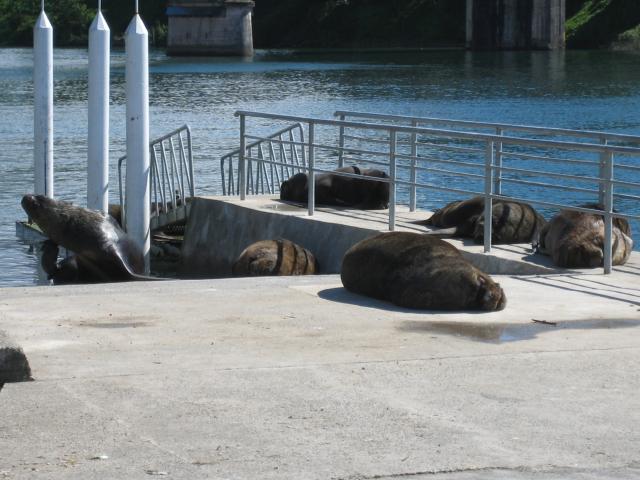
OK, so this picture doesn’t do justice to the fear and loathing that we felt in our hearts because there’s nothing to give scale to the size of these massive, pre-historic beings. These things are unnaturally huge because they are fed on a daily basis by the local fishermen. They are huger than huge. They are a massive pile of fat that has a head that will twitch and a tail that will twitter (I’ve always wanted to say the word, “twitter.” A bit of a strange word, eh?). If you get too close to these monstrosities they will make an attempt to thwart you by a loud noise and a big movement of their unnaturally-large head. This is sufficiently scary to ward off the bravest of people.
The kids have been watching a little bit of cartoons on TV here, and it’s all in Spanish. I’ve been hopeful that we’d experience what everyone has told us—children pick up languages much faster than adults. I figured that if we let them watch a couple hours of Spanish cartoons they’d be fluent in no time; or at least fluent enough to allow us to evade Acme fireworks, or help Scooby solve the Monstre de Electricidad mystery.
Unfortunately this is not the case because I tested them this morning. I asked both of them to conjugate the verb, “eat” which is, “comer.” I wanted all the present tenses, with examples.
They couldn’t do one bit of this test! Can you believe that?! So much for the experts thinking that kids can learn languages faster than adults… Tomorrow is the testing of the indefinite and predicate forms of the verb “be.” The little ones better get them right or there’s no ice cream for them…
October 25, 2006
Pucon
Pucon is a town that’s situated at the base of a volcano. We can’t prove this because when we arrived, the volcano was brilliantly illuminated in the afternoon sky but we didn’t take any pictures; the rest of the days in Pucon the volcano was behind a bunch of clouds. But believe us when we say that Pucon is a very picturesque place with an incredibly beautiful volcano as its main attraction.
We hung out in Pucon. The town reminded us of Aspen, Colorado. Very picturesque, very cool architecture, very outdoorsy clientele. And they had a really cool plaza (a South American plaza is in about every city—it’s a block that’s dedicated to a lot of grass, trees, and benches, and it’s a place in which to meet and rest). We went to the Pucon plaza one day as the local school kids were getting out of school for some exercise. They were really interested in the music that I played—it’s good to have a very forgiving audience. Since they don’t know the music, they don’t know when I messed up.
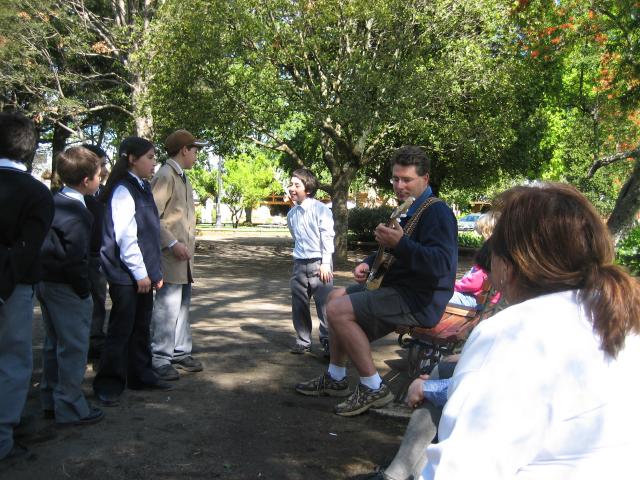
October 28, 2006
I had to go to the pharmacy this morning to get some tissues for the girls and some nose spray for me. Yes, my name is Darren Rousseau I’ve been addicted to nose spray for several years.
They don’t speak English at this particular pharmacy and everything in the pharmacy is behind the counter. There is no such thing as a medical need that you can serve yourself—band aids, cotton swabs, cough medicine, eye drops, even tissues are behind the counter. I find this to be a bit degrading, as I like a little bit of anonymity in my pharmaceutical purchases. After all, who needs to know that I purchased 4 enemas? Really...
So this is an exercise in Charades for me. A nice lady approached me and, because she was wearing the Pharmacist smock, I knew she was asking what I wanted. I got out my empty nose spray bottle (I was prepared) and pointed to it and said, “Un mas, por favor?” This means, “Good morning. How are you this bright and lovely day? I would like to purchase another bottle of nose spray. The brand is not important but it must have Oxymetazoline HCI 0.05% as the active ingredient. Thank you in advance for your help.”
She smiled and found what I wanted behind the counter. She then rattled off more Spanish, or French, or Dutch—they talk so fast who knows what language they speak? Again using Darren’s Guide to Spanish, I understood that she was asking if I wanted to purchase any additional products or services.
I pointed to my nose and made a blowing sound. This is the internationally known method of saying, “Yes, I have additional nasal issues. I would like to buy one additional product, if you please. I require a small package of tissues.”
She came back with a small package of tissues.
So I feel confident that I can speak to anyone in any language. I am the Universal Translator--It’s a movie, three words, first word, 4 syllables…
October 29, 2006
We returned to Ian and Maggie’s Place (IMP) for another 6 days. Can there be a better compliment for how great a place is than our actions? Actually, I was a bit put out that I didn’t get the bee tour the first time that I had to get it the second time around. So Ian scheduled me into his work schedule because his main bee-guy was in the hospital with a hernia. I was up to the challenge; I was bee-man.
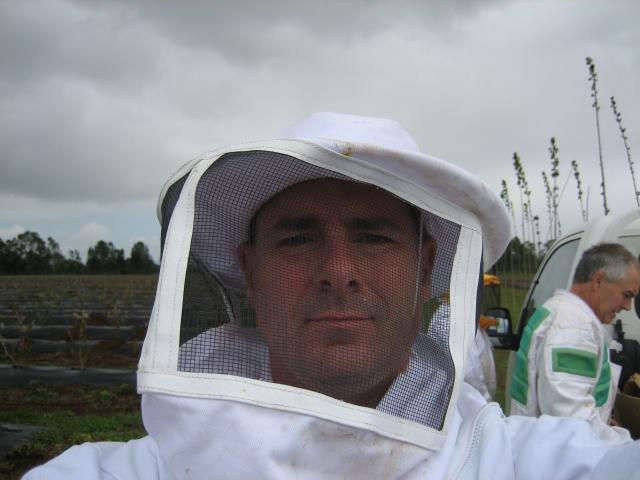
Look at me in the cool suit. I like to call it my astronaut suit. I also call it my chick-pickup suit. It makes my butt look small.
The task of the day was to feed the various bee hives because the weather was windy and cold. If it’s too cold, the bees don’t get out of the hives to gather pollen and nectar and they’ll starve. Similar to me—if it’s too hot I won’t go outside to buy food and we’ll all starve. If you know this about the bees, then you can put a sleeve into their hives that contains a sugar substance that they’ll eat and continue to produce honey in the cold weather.
Video: Bees
This is bee keeping in real life. The bees were fairly calm all afternoon long until we got to a spot that was sheltered from the wind. Then they became a bit aggressive and we had to put the smoke on them. If the smoke didn’t calm them down, then I would have had to put the smack down on them—put them in the small bee-sleeper hold.
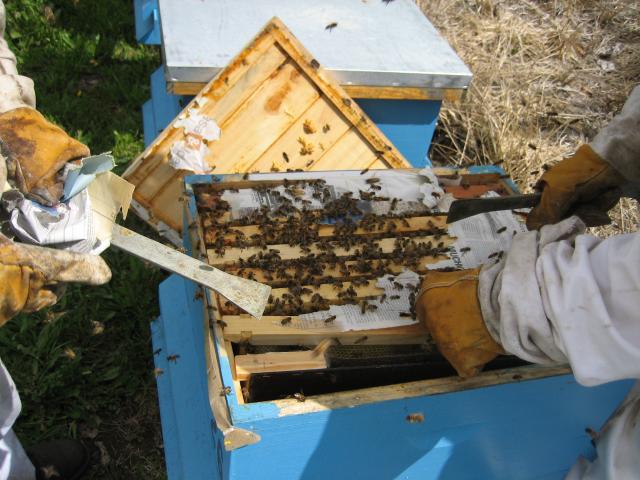
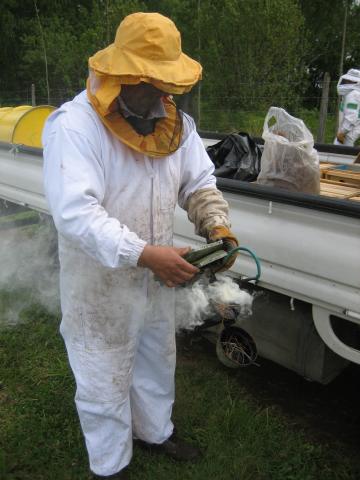
So our afternoon was about taking the top off each hive, making sure each hive had a viable queen and each “blade” was populated, and making sure that each hive had adequate food in the form of the sugar substance. If anything was askew in either of these variables then we had to add food, move blades from one hive to another, or show some sort of “bee snuff movie” and give them a couple bottles of beer to get them to breed with the queen bee. I kept trying to tell the male bees that the queen bee had a good personality—that seemed to work as well in the bee world as it does in the human world.
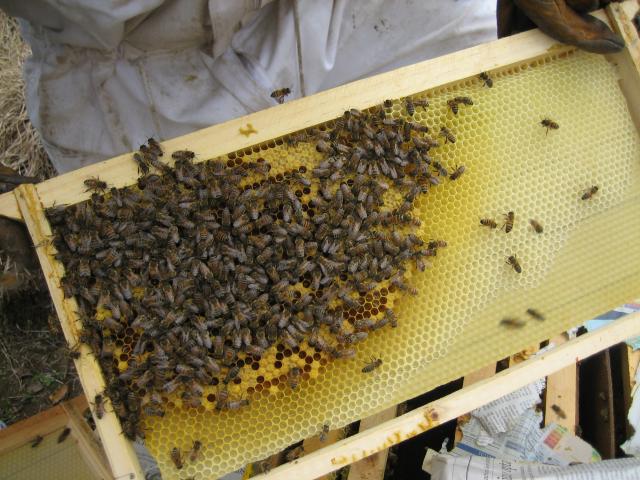
Perhaps the queen is less-receptive than normal, or the males are a bit shy and need some encouragement. We all know and understand about performance anxiety, so the less pressure we can give these male bees the better. If all fails, then I think Ian is prepared to play subliminal messages in bee-like adult movies.
I kid. The bees are an incredible microcosm of activity; their movements are well-documented and their needs are known. The challenge is to find environments in which they will thrive, and co-exist with natural products so they produce the highest quality honey. This is an amazing challenge and opportunity that Ian and Maggy have, and it was so cool to be a very small part of this.
|